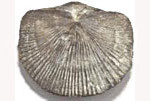
Euphausia superba
There are around 85 krill species, ranging in size from 1cm to 14cm. The dominant species in the southern polar waters is the Antarctic krill (Euphausia superba), a small shrimp-like crustacean which plays a key role in the Antarctic food web. Krill is considered to be a keystone species, as it is the staple food of many fish, birds and mammals in the Southern Ocean. They are exclusively marine and have a life span of about 5 to 10 years. They are one of the most abundant and successful animal species on the planet. The total biomass of krill exceeds that of the human race. Put another way, the combined weight of the planet’s krill population is greater than the combined weight of every man, woman and child on earth. Antarctic krill occur in groups or large swarms and occupy a niche similar to that of the herring in the North
Atlantic, since large schools of pelagic fish are absent in these waters. They grow to 6 cm and weigh around 1g, feeding primarily on phytoplankton (microscopic plant life) or sea ice algae. They have five pairs of swimming legs, large black eyes and congregate in huge swarms near the surface, which can colour the water from pink to orange to red. They are mostly transparent, although their shell is tinged a bright red by small pigment spots. Their digestive system often reflects the pigmentation from their phytoplankton diet, and can appear as a vivid green. The overall appearance of live specimens is quite beautiful.
The krill’s feeding mechanism is a dense comb of hair along a further six pairs of forward legs, each of which is split into two branches and covered with a net-like array of feathery seta (stiff hair). This is designed to filter phytoplankton from the water column and to scrape algae from the ice.
There is a degree of uncertainty as to how krill survive the Antarctic winter. They do not appear to build up reserves of fat, so must either use some food available under the ice such as sea-ice algae, detritus on the sea floor, or perhaps become omnivorous and supplement their normal phytoplankton diet with other animals in the water. There is laboratory evidence to suggest that Antarctic krill can survive for 200 days without food, using up the very material of their body to meet their metabolic needs and shrinking in the process.
Apart from frequenting the sea ice to feed, krill, in particular juveniles, seek protection from predators in the many nooks and crannies formed by the deformed sea ice floes.
Krill spend their days at depths of around 100 m, generally safe from their major predators. They swim to the surface at night to feed, congregating in huge swarms, often thousands of metres across at densities of thousands per square metre, attracting large carnivorous animals such as baleen whales, seals, pelagic fish and sea birds.
The Antarctic krill is also caught commercially for human and livestock consumption, with an annual catch of around 120,000 tonnes.
When surveying krill during your dive, you may come across just a few of the indicator species, or indeed a large ‘swarm’. If just a few, then record the numbers as accurately as possible. If you encounter a large aggregation then it should be recorded as abundant, i.e. 5 on the DAFOR scale. You could also try to estimate the size of the krill ‘swarm’ (in cubic metres) if it is distinct enough to do so, and also record the number of ‘swarms’ seen during the dive if there is more than one.







Social Profiles